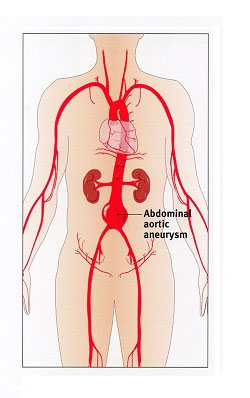
Aneurysm also known as aneurism is a medical condition characterized by balloon like dilation of a part (localized) of the walls of a blood vessel. In case of abdominal aortic aneurysm the bulging occurs in the lower (abdominal) segment of the largest artery of the body, the aorta. The aorta arises from the left side of the heart and it is as thick as a garden hose. It crosses the chest cavity as thoracic aorta ad then abdominal cavity as abdominal aorta. Abdominal aortic aneurysm is the most common type of aortic aneurysm; the affected part of the abdominal aorta becomes enlarged by 50% of its original diameter. Inmost of the cases (in about 90% cases) the location of the aneurysm in the abdominal aorta is below the kidneys (infrarenally) however aneurysm may occur at the level of kidney (pararenally) or above the kidneys (suprarenally).
This condition is usually seen in males between 65 and 75 years of age and with a habit of smoking. In most of the affected persons as such there is no symptom however abdominal pain, due to increased pressure over the adjacent abdominal structures or leg pain due to obstruction in blood flow to the legs by the bulge of the aneurysm may occur. The most dreadful complication of abdominal aortic aneurysm is sudden rupture of the aneurysm and subsequent large amount of blood loss in the abdominal cavity which may result into death of the person due to excessive blood loss. Even immediate hospitalization and emergency repair of the ruptured aorta has about 60 to 90% mortality rate.
Usually treatment (surgery) is recommended when the size of the aneurysm grows above 5.5 cm in people with smaller aneurysm watchful monitoring is advised. Treatment options include open surgery and endovascular aneurysm repair (EVAR). EVAR is usually performed depending upon the individual patient as mortality rate following EVAR is about 0.5% in comparison to 3% following open surgery.
Symptoms
In most of the cases of abdominal aortic aneurysm there is as such no symptom. The condition is mostly diagnosed on abdominal ultrasound examination done for other purposes. It is difficult to almost impossible to predict how fast an aneurysm will grow in size; some of the aneurysms remain small throughout the patient’s life whereas some grow very fast and carries high risk of rupture.
There are certain presenting symptoms of a growing abdominal aortic aneurysm; these are experiencing a pulsation near the naval area of the abdomen, deep seated and persistent pain in the sides or central portion of the abdomen, pain in the lower back etc.People with family history of aneurysm especially males with history of smoking and more than 65 years of age should consult the doctor regarding periodic screening for the condition. For women as such no such recommendations are there however ultrasound screening might be recommended after evaluating individual risk factors.
The commonest complication of abdominal aortic aneurysm is tear in the walls of the vessel and rupture of the aneurysm leading to life threatening blood loss. The risk of rupture of the aneurysm increases with the increase in size of the aneurysm. Common presenting symptoms of ruptured aneurysm include sudden onset severe pain in the abdomen which may radiate to the back or legs, excessive perspiration, cold, clammy limbs, fall in blood pressure, nausea, vomiting, difficulty in breathing, sudden black out etc.
Another complication associated with abdominal aortic aneurysm is presence of blood clots (thrombus) in the aneurysm. These clots tend to get dislodged from their site of origin and get lodged at another blood vessel (embolus) resulting into obstruction of blood flow through them leading to various symptoms like pain in the legs, toes etc.





